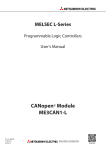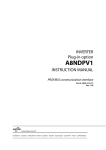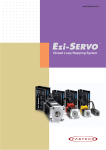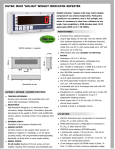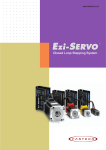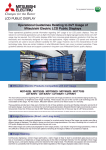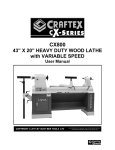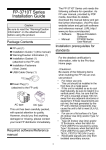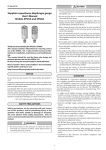Download Installation Manual for CANopen Module ME3CAN1-Q
Transcript
Overview Installation and Wiring The ME3CAN1-Q is used to connect a MELSEC System Q PLC system to CANopen쏐 and CAN Layer 2 networks. CAN (Controller Area Network) is a serial bus system especially for networking devices as well as sensors and actuators. MELSEC System Q ME3CAN1-Q � RUN b CAN RUN TX/RX CAN ERR. ERR. Installation Manual for CANopen쏐 Module ME3CAN1-Q Safety Information � For qualified staff only This manual is only intended for use by properly trained and qualified electrical technicians who are fully acquainted with automation technology safety standards. All work with the hardware described, including system design, installation, setup, maintenance, service and testing, may only be performed by trained electrical technicians with approved qualifications who are fully acquainted with the applicable automation technology safety standards and regulations. Proper use of equipment b WARNING: Equipment and property damage warnings. Failure to observe the precautions described here can result in serious damage to the equipment or other property. Description RUN ERR 쎲 Normally operating 쑗 Hardware error (watch dog timer error) or power failure 쎲 An module error has occurred. 쑗 Normally operating 폷 CAN RUN � Status LEDs The following manuals contain further information about the module: ● Hardware manuals for the MELSEC System Q ● User's Manual for the CANopen쏐 module ME3CAN1-Q ● MELSEC-Q/L Programming Manual Registration ● CiA쏐 and CANopen쏐 are registered Community Trademarks of CAN in Automation e.V. ● The company name and the product name to be described in this manual are the registered trademarks or trademarks of each company. ● When drilling screw holes or wiring, cutting chips or wire chips should not enter ventilation slits. Such an accident may cause fire, failure or malfunction. ● Make sure to affix the CAN bus connector with fixing screws. Tightening torque should be within 0.20 to 0.28 Nm. Loose connections may cause malfunctions ● Do not disconnect the CAN bus cable connected to the ME3CAN1-Q by pulling the cable section. Be sure to hold the connector connected to the ME3CAN1-Q. Pulling the cable while it is connected to the ME3CAN1-Q may lead to malfunctioning or damage of the ME3CAN1-Q or cable. ● A protective film is attached onto the module top to prevent foreign matters such as wire chips entering the module during wiring. Do not remove the film during wiring. Remove it for heat dissipation before system operation. ● Do not bundle or adjacently lay the communication cable connected to the ME3CAN1-Q with the main circuit line, power line, or the load line other than that for the PLC. Separate these by 100 mm as a guide. Failure to observe this could lead to malfunctioning caused by noise, surge, or induction. ● Before handling modules, touch a grounded metal object to discharge the static electricity from the human body. Not doing so may cause failure or malfunctions of the module. ● Place the communication cable in grounded metallic ducts or conduits both inside and outside of the control panel whenever possible. CAN ERR Torque Module fixing screw (M3, optional) 0.36 to 0.48 Nm Relation between bus length and cable cross section b Bus length [m] WARNING Length-related resistance (m⏲/m) 0 to 40 0.3 to 0.34 70 40 to 300 0.34 to 0.60 쏝60 ● Do not open or modify a module. Doing so can cause a failure, malfunction, injury or fire. 300 to 600 0.50 to 0.60 쏝40 600 to 1000 0.75 to 0.80 쏝26 LSS Services in progress 쏆 CANopen쏐 mode: The device is in CANopen쏐 state Pre-operational. 왕 The device is in CANopen쏐 state Stopped. ● Always insert the module fixing latch of the module into the module fixing hole of the base unit. Forcing the hook into the hole will damage the module connector and module. 쑗 Layer 2 mode: The device is in Layer 2 offline mode. ● Do not touch the conductive parts of the module directly. Doing so can cause a unit malfunction or failure. 쎲 Module is transmitting or receiving CAN messages. 쑗 Module is not transmitting or receiving CAN messages. 쎲 폷 폷 왖 LSS Services in progress For details, refer to CiA쏐 303. 햲 After switching off the power supply, insert the module fixing latch into the module fixing hole of the base unit. The CAN controller is Bus-OFF-state. The CAN controller has too many transmission errors. 쏆 General error 폷 Cable cross section (mm2) ● Do not drop the module or subject it to heavy impact. 왖 폷 Use twisted pair shielded cable (2 pairs) with a cross section of 0.3 to 0.82 mm2 and an impedance of 120 :. (The relation between the bus length and the cross section of the wires to be used is given below.) The cables should conform to ISO 11898/1993. Mounting a module to a base unit 폷 앳 � CANopen쏐 mode: The device is in CANopen state Operational. Layer 2 mode: The device is in Layer 2 online mode. Applicable Cable Screw 쎲 Tx/Rx Further Information These manuals are available free of charge through the internet (https://eu3a.mitsubishielectric.com). If you have any questions concerning the installation, configuration or operation of the equipment described in this manual, please contact your relevant sales office or department. WARNING Tighten the module screw within the following range. No. All safety and accident prevention regulations relevant to your specific application must be observed in the system design, installation, setup, maintenance, servicing and testing of these products. In this manual special warnings that are important for the proper and safe use of the products are clearly identified as follows: m ● Always confirm the connector layout before connecting the CAN bus to the ME3CAN1-Q. ME3CAN1-Q Relevant safety regulations DANGER: Personnel health and injury warnings. Failure to observe the precautions described here can result in serious health and injury hazards. WARNING ● Make sure that foreign matter such as cutting chips and wire scraps does not enter the ME3CAN1-Q. Failure to observe this could lead to fires, faults or malfunctioning. ● Use the product in the environment within the general specifications described in the Hardware Manual for the MELSEC System Q. Never use the product in areas with dust, oily smoke, conductive dusts, corrosive or flammable gas, vibrations or impacts, or expose it to high temperature, condensation, or wind and rain. CAN I/F Art.no.: 279870 ENG, Version A, 09102014 The programmable controllers (PLC) of the MELSEC System Q are only intended for the specific applications explicitly described in this manual or the manuals listed below. Please take care to observe all the installation and operating parameters specified in the manual. All products are designed, manufactured, tested and documented in agreement with the safety regulations. Any modification of the hardware or software or disregarding of the safety warnings given in this manual or printed on the product can cause injury to persons or damage to equipment or other property. Only accessories and peripherals specifically approved by MITSUBISHI ELECTRIC may be used. Any other use or application of the products is deemed to be improper. b DANGER Turn off all phases of the power supply for the PLC and other external sources before starting the installation or wiring work. Part Names Programmable Controllers m Wiring NMT guarding failure (NMT-Slave or NMT-Master) Heartbeat failure 왕 Warning limit reached 쑗 No error 햳 Push the module in the direction of the arrow to load it into the base unit. CANopen쏐 interface connector (D-sub 9-pin male connector) 쎲: LED ON 왖: Flickering (0.05 s ON, 0.05 s OFF) 쏆: Blinking (0.2 s ON, 0.2 s OFF) 앳: Two short flashes (0.2 s each) followed by a pause of 1 s 왕: One short flash (0.2 s) followed by a pause of 1 s 쑗: LED OFF 햴 Secure the module with an additional screw (M3 x 12) to the base unit if large vibration is expected. This screw is not supplied with the module. Mitsubishi Electric Europe B.V. /// FA - European Business Group /// Germany /// Tel.: +49(0)2102-4860 /// Fax: +49(0)2102-4861120 /// https://eu3a.mitsubishielectric.com Pin Configuration Specifications Grounding of the twisted pair CAN bus cable MELSEC System Q PLC General Specifications External dimensions Threaded hole to fix CAN bus connector 5 . . . . 1 9 . . . 6 Power supply CPU ME3CAN1-Q ME3CAN1-Q No. of occupied I/O points 32 (I/O assignment: 32 intelligent points) Internal current consumption (5 V DC) 0.34 A Weight 0.12 kg ME3CAN1-Q RUN ERR. CAN bus cable CAN RUN TX/RX CAN ERR. CAN I/F Performance Specifications NOTE ME3CAN1-Q An inch screw thread (#4-40UNC) is used to fix the connector to the ME3CAN1-Q. For noise prevention please attach at least 35mm of the shield from the twistedpair CAN bus cable to the grounding with a shielding connection clamp. Pin Item 98 Grounded mounting plate or grounded DIN rail with a grounding resistance of 100 : or less (Class D). Signal Description 1 — Reserved 2 CAN_L CAN_L bus line (dominant low) 3 CAN_GND CAN ground 4 — Reserved 5 CAN_SHLD CAN shield 6 — Reserved 7 CAN_H CAN_H Bus line (dominant high) 8 — Reserved 9 — Reserved Ground the communication cables as follows: ● The grounding resistance should be 100 : or less. ● The grounding point should be close to the ME3CAN1-Q. Keep the grounding wires as short as possible. ● Independent grounding should be performed for best results. When independent grounding is not performed, perform "shared grounding" of the following figure. ME3CAN1-Q Other equipment Independent grounding Best condition ME3CAN1-Q Other equipment Shared grounding Good condition ME3CAN1-Q Other equipment Common grounding Not allowed Item ME3CAN1-Q Transmission type CAN Bus network (RS485, CSMA/CR) Applicable functions 앫 CANopen쏐 Node 앫 CAN Layer 2 Node CANopen쏐 communication services according to CiA쏐 standards 앫 CiA쏐-301 V4.2 앫 CiA쏐-302 V4.1 앫 CiA쏐-305 V2.2 CANopen쏐 device and application Interface and Device Profile CiA쏐-405 profiles according to CiA쏐 V2.0 for IEC 61131-3 Programmable standards Devices Remote Transmit Request (RTR) 앫 Layer 2 mode: supported 앫 CANopen쏐 mode: not supported for PDO Node number Selectable from 1 to 127 Communication method Acyclic, cyclic or event-driven The maximum bus length varies depending on the transmission speed. b WARNING Supported transmission speed / maximum bus length Leave the "reserved" pins unconnected. CAN-Bus Wiring � � CAN_GND CAN_GND Connection cable CAN_GND CAN_L CAN_L CAN_L CAN_SHLD CAN_SHLD CAN_SHLD CAN_H CAN_H CAN_H CAN_V+ CAN_V+ CAN_V+ � � � � � No. Description 쐃 Terminating resistor (120 :, 0.5 W) It is recommended to use a CAN bus connector with built-in bus terminator. 쐇 4-core shielded twisted pair cable 쐋 Class-D Grounding (100 : or less) For electromagnetic compatibility (EMC), it is recommended to ground the cable shield at both ends. 쐏 Optional external supply for transmission hardware b 앫 1 Mbps / 25 m 앫 800 kbps / 50 m 앫 500 kbps / 100 m 앫 250 kbps / 250 m 앫 125 kbps / 500 m 앫 100 kbps / 600 m 앫 50 kbps / 1,000 m 앫 20 kbps / 2,500 m 앫 10 kbps / 5,000 m The cable should conform to ISO11898. (Refer to section "wiring") Connection to CANopen쏐 network via 9-pin D-sub connector � WARNING For safety, always check the potential differences between the grounding points. If potential differences are found, proper measures must be taken to avoid damage. Insulation method 앫 Photocouplers are used to insulate the CAN input from the PLC. 앫 A DC/DC converter is used to insulate the power supply from the CAN input. Online module change Not supported 27.4 All dimensions are in "mm". 90


